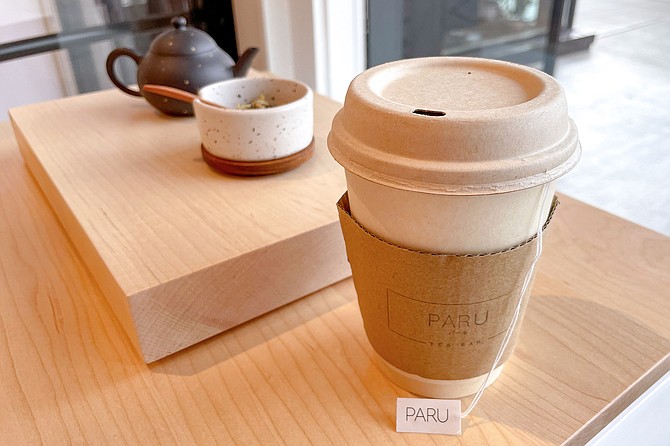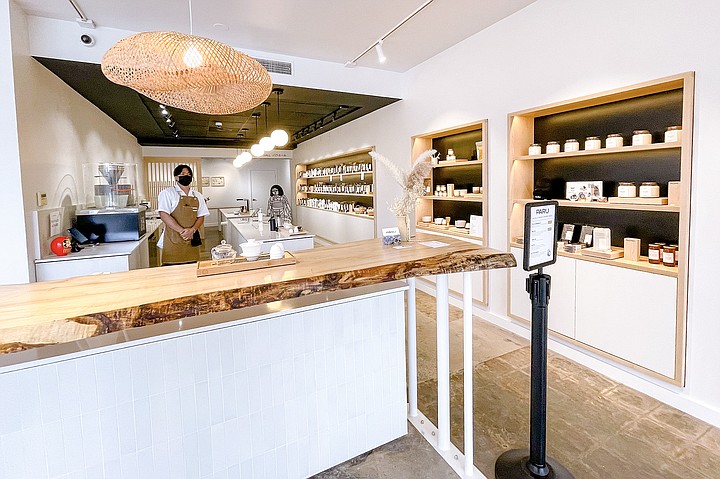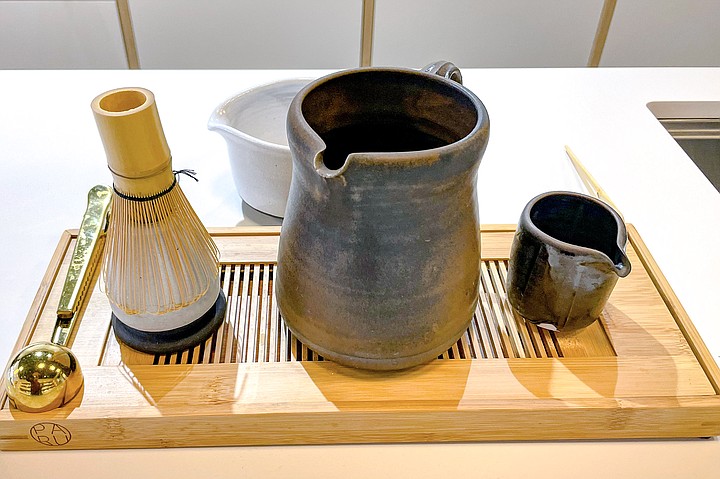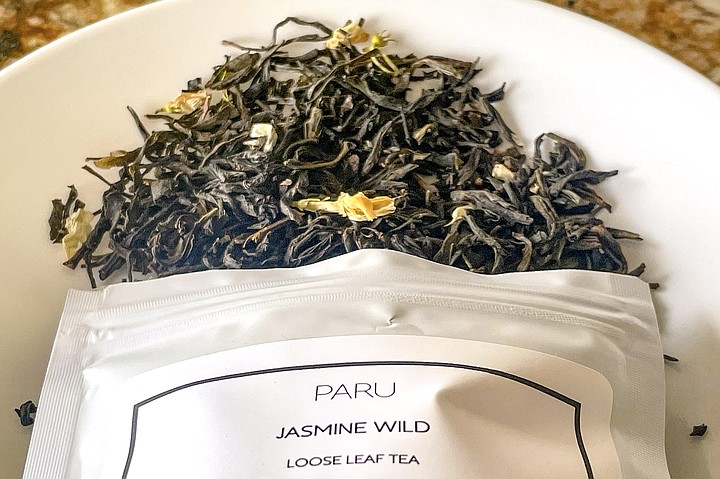 Facebook
Facebook
 X
X
 Instagram
Instagram
 TikTok
TikTok
 Youtube
Youtube

Most afternoons, I would be disappointed to make the trek into La Jolla only to find the peninsula sheathed in fog. But on this day, I would welcome the chill, because there’s a new tea bar in La Jolla Village. Before long, there’d be a hot brew in my hand.
Now in its fifth year as a tea company, Paru was founded by married couple Amy Truong and Lani Gobaleza. The started the business first as a pop-up, eventually establishing a cozy tea shop in Shelter Island in 2019. Their new Girard Avenue location feels like a big step forward. It’s roughly twice the size of the Point Loma shop, and designed to be light, airy, and contemporary. Even with the fog, sunlight found its way through the shop’s tall windows, to liven up the custom wood grains accenting the space.
Thanks to what I presume is a cosmic coincidence, when I came looking for the Paru storefront, I found myself standing in front of a sushi restaurant called Haru. After a moment of confusion (did my mapping software get the names mixed up?) I realized that Paru resides next door to the restaurant, with less visible signage, so far.

I’m told the proprietors actually met while studying in Japan, where the word paru refers to a bosom friend (and haru means springtime). The couple further explored Japan to study tea and tea ceremony and have returned since to source many of their teas from the archipelago. Had the weather been warm during my visit, I certainly would have ordered a matcha latte. Paru has invested in a mill to produce its own version of the green tea powder, and teamakers whisk it by hand in the shop, using a traditional bamboo chasen to achieve proper results.
In terms of ready-to-drink tea service, matcha may prove to be the top reason to visit the shop in person — for a tea drinker, the bottomless umami depths of expertly brewed matcha tea cannot be oversold.

But it’s far from the only draw. The welcoming staff (which included one of the owners) immediately offered to prepare a sample of a featured oolong offering that Paru calls Honey Orchid. Sure enough, the floral cup boasts a light, natural sweetness and texture reminiscent of honey.
Like many tea shops, Paru offers a breadth of tea varietals and herbal teas (a.k.a. tisanes). True teas (those from the tea plant) are differentiated based on how they’re dried and otherwise processed. So you have floral green teas (no oxidation); subtly flavored white teas (lightly oxidized); Oolong teas (lightly oxidized and fermented); earthy and full-flavored black teas (oxidized and fermented); and Pu-erh (oxidized, fermented, and aged), which tends to yield a smooth, dark brown tea with sweet and earthy notes.

What differentiates Paru is that most loose leaf tea purveyors source their product from China. Gobaleza and Truong source from Japan, as well as from the southeast Asian countries Thailand, Laos, and Vietnam, where Truong has familial roots.
To take home, I picked up a jasmine green tea dubbed Saigon Wild ($18 for 2 ounces of loose leaves), harvested from wild trees in Vietnam’s Ha Giang province. I’m sure a side by side comparison with any number of Chinese grown green teas would highlight differences in terroir. But for my pay grade, I can attest these leaves produce a flowery beverage with lower bitterness than I’m accustomed to. I’ll enjoy sipping it this winter.

The Paru team didn’t blend the jasmine petals in-house, but they do create their own, unique tea blends. For example, a Pandan Waffle blend takes inspiration from the Vietnamese dessert to bolster Thai-grown assam black tea with roasted sticky rice and coconut. And they recently blended that honey orchid oolong with rind of the calamansi citrus fruit, in a nod to Gobaleza’s Filipino heritage.
Of course, I couldn’t leave the shop without taking a $5 cup of hot, brewed tea to go. For that, I told Truong my usual tea drinking preferences, and she nailed a recommendation, offering a tea they call Phongsaly black. Its leaves, picked from a 400-year-old tree in Phongsaly, Laos, stand out for a hint of cherry. The caffienated brew proved a beautiful foil to that stubborn marine layer.


Most afternoons, I would be disappointed to make the trek into La Jolla only to find the peninsula sheathed in fog. But on this day, I would welcome the chill, because there’s a new tea bar in La Jolla Village. Before long, there’d be a hot brew in my hand.
Now in its fifth year as a tea company, Paru was founded by married couple Amy Truong and Lani Gobaleza. The started the business first as a pop-up, eventually establishing a cozy tea shop in Shelter Island in 2019. Their new Girard Avenue location feels like a big step forward. It’s roughly twice the size of the Point Loma shop, and designed to be light, airy, and contemporary. Even with the fog, sunlight found its way through the shop’s tall windows, to liven up the custom wood grains accenting the space.
Thanks to what I presume is a cosmic coincidence, when I came looking for the Paru storefront, I found myself standing in front of a sushi restaurant called Haru. After a moment of confusion (did my mapping software get the names mixed up?) I realized that Paru resides next door to the restaurant, with less visible signage, so far.

I’m told the proprietors actually met while studying in Japan, where the word paru refers to a bosom friend (and haru means springtime). The couple further explored Japan to study tea and tea ceremony and have returned since to source many of their teas from the archipelago. Had the weather been warm during my visit, I certainly would have ordered a matcha latte. Paru has invested in a mill to produce its own version of the green tea powder, and teamakers whisk it by hand in the shop, using a traditional bamboo chasen to achieve proper results.
In terms of ready-to-drink tea service, matcha may prove to be the top reason to visit the shop in person — for a tea drinker, the bottomless umami depths of expertly brewed matcha tea cannot be oversold.

But it’s far from the only draw. The welcoming staff (which included one of the owners) immediately offered to prepare a sample of a featured oolong offering that Paru calls Honey Orchid. Sure enough, the floral cup boasts a light, natural sweetness and texture reminiscent of honey.
Like many tea shops, Paru offers a breadth of tea varietals and herbal teas (a.k.a. tisanes). True teas (those from the tea plant) are differentiated based on how they’re dried and otherwise processed. So you have floral green teas (no oxidation); subtly flavored white teas (lightly oxidized); Oolong teas (lightly oxidized and fermented); earthy and full-flavored black teas (oxidized and fermented); and Pu-erh (oxidized, fermented, and aged), which tends to yield a smooth, dark brown tea with sweet and earthy notes.

What differentiates Paru is that most loose leaf tea purveyors source their product from China. Gobaleza and Truong source from Japan, as well as from the southeast Asian countries Thailand, Laos, and Vietnam, where Truong has familial roots.
To take home, I picked up a jasmine green tea dubbed Saigon Wild ($18 for 2 ounces of loose leaves), harvested from wild trees in Vietnam’s Ha Giang province. I’m sure a side by side comparison with any number of Chinese grown green teas would highlight differences in terroir. But for my pay grade, I can attest these leaves produce a flowery beverage with lower bitterness than I’m accustomed to. I’ll enjoy sipping it this winter.

The Paru team didn’t blend the jasmine petals in-house, but they do create their own, unique tea blends. For example, a Pandan Waffle blend takes inspiration from the Vietnamese dessert to bolster Thai-grown assam black tea with roasted sticky rice and coconut. And they recently blended that honey orchid oolong with rind of the calamansi citrus fruit, in a nod to Gobaleza’s Filipino heritage.
Of course, I couldn’t leave the shop without taking a $5 cup of hot, brewed tea to go. For that, I told Truong my usual tea drinking preferences, and she nailed a recommendation, offering a tea they call Phongsaly black. Its leaves, picked from a 400-year-old tree in Phongsaly, Laos, stand out for a hint of cherry. The caffienated brew proved a beautiful foil to that stubborn marine layer.
Comments